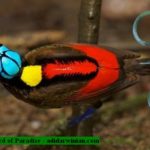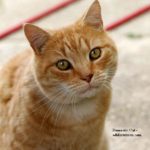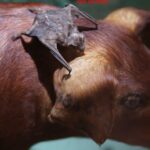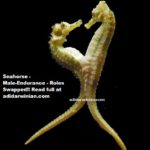The Hedgehog – the Spiny Ball!!
A Piece of Poetry, from the Pen of an Earnest Biologist (Aditya Sardana aka Adidarwinian), dedicated to The Hedgehog – the Spiny Ball!!
“Look out under the log,
There lives a hedgehog,
It does not appear when the Sun shines,
Only to appear in the night as a ball of spines.”
Hedgehogs are found in the Europe, Africa, and Asia. Hedgehogs are the insectivorous (feeding on insects; insectivores) animals belonging to the subfamily Erinaceinae of the family Erinaceidae of the order Erinaceomorpha of the class Mammalia. Other members of the family Erinaceidae include the gymnures (subfamily Galericinae). The name “hedgehog” comes from its occurrence in the hedges or hedgerows, the pig-like (hog-like) snout, and the pig-like deep guttural sound made by it while searching for food.
Hedgehogs are nocturnal mammals and omnivorous (eating both plants and animals as food) in nature. They feed on insects, snails, slugs, birds, carrion (dead and decaying flesh), reptiles, snakes, roots, and fruits. An interesting point to be noted here is that a hedgehog is immune to the snake bite. Some of the species hibernate in the winter season. These animals can be found in the bushes, under the logs, in the hedges or hedgerows, under the rocks, and in the subterranean channels like burrows. Natural habitats of these animals include steppe, grasslands, pastures, scrubs, cultivated fields, temperate fields, gardens, dunes or sand dunes, semi-desert areas, hot and dry deserts, etc.
The body of a hedgehog is globular in shape and the head is small. Size ranges from that of a mouse to the size of a small rabbit. Eyes are small and black, and the pinnae (A pinna (singular form) or an auricle is the external projecting part of the ear) are of small size. The pinnae of Hemiechinus auritus (long-eared hedgehog) are much larger than the pinnae of other species. Large size of the pinnae in this species is thought to be an adaptation for heat radiation in its desert habitat. On the dorsal surface (back or upper surface) of the body are present sharp projecting spines. These barbless spines are actually the modified hairs. The ventral surface (front or lower surface) of the body is covered with soft fur. The legs are short and thin, tail is very small or stumpy, and the snout is tubular and pointed. A hedgehog moves its spiny area through a sphincter formed by a band of muscles which passes over the neck, along the sides, and over the base of the tail.
Another interesting point, which is worthy of being considered here, about this nocturnal mammal is that when it is disturbed or is in danger, it rolls up its body into a ball in such a way that the projecting spines now cover the tail and head also. The outwardly projected spines afford full protection to the body, tail, and head of this animal just as the pins in a pincushion. Gymnures, the other members of the family Erinaceidae, lack spines on their bodies. When gymnures are disturbed or threatened, they produce a foul smell in order to protect themselves. Also, the gymnures are not strictly nocturnal as they might be active during the daytime. Although Erinaceids (members of the family Erinaceidae) are mainly terrestrial animals (animals living on or in the ground; not living in the water, trees, or air), they are still good climbers and swimmers.
Hedgehogs have one or two breeding seasons in a year. The breeding time is usually the only time when the adult animals associate with each other. At other times, these insectivorous mammals live a solitary life. The young ones of these insect-eating mammals are born with soft spines which harden quickly.
In India, this animal is known by the name of “Jhau Chua”. Some of the recognized species of hedgehogs are listed below –
- Erinaceus europaeus (also called as European hedgehog or western European hedgehog)
- Erinaceus concolor (also called as eastern European hedgehog)
- Erinaceus roumanicus (also called as northern white-breasted hedgehog)
- Erinaceus amurensis (also called as Amur hedgehog)
- Paraechinus micropus (also known as Indian hedgehog)
- Paraechinus aethiopicus (also known as desert hedgehog)
- Paraechinus nudiventris (also known as bare-bellied hedgehog)
- Paraechinus hypomelas (also known as Brandt’s hedgehog)
- Hemiechinus auritus (this species consist of the long-eared hedgehog)
- Hemiechinus collaris (this species consist of the Indian long-eared hedgehog)
- Atelerix frontalis (this species consist of the southern African hedgehog)
- Atelerix algirus (this species consist of the North African hedgehog)
- Atelerix albiventris (this species consist of the four-toed hedgehog or the African pygmy hedgehog)
- Atelerix sclateri (also known as Somali hedgehog)
- Mesechinus hughi (also known as Hugh’s hedgehog)
- Mesechinus dauuricus (also known as Daurian hedgehog)








Hedgehogs are to be protected as they are nature’s gift to mankind.
Great – It is the perfected article on Hedgehog!!
I really liked the interesting points given in this post about the hedgehogs.
I shall call this great article as the Poetic Knowledge!!
A Lively Combination of Knowledge and Poetry for all the Animals and Pets Lovers!!